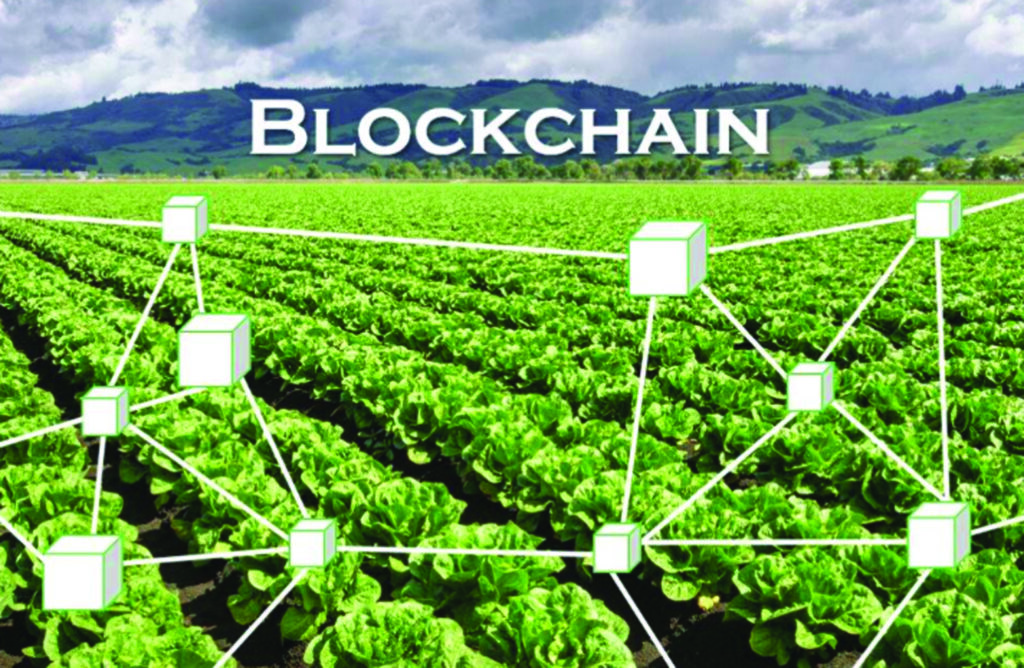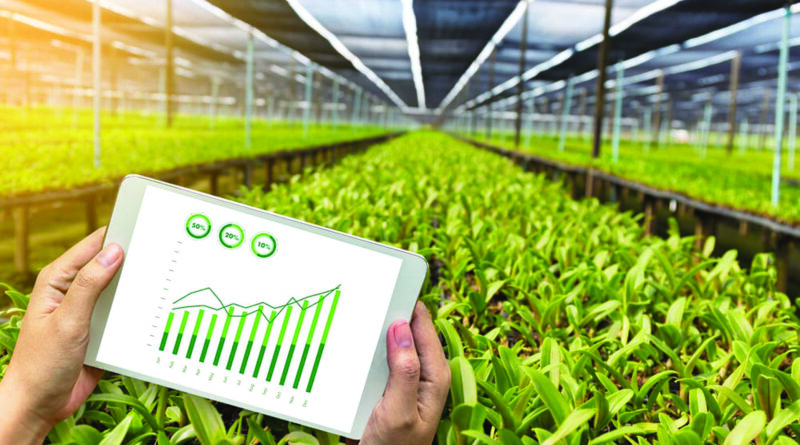Blockchain Technology for Agriculture: Applications and Rationale
Introduction
The use of data and information becomes increasingly crucial for the agriculture sector to improve productivity and sustainability. Information and Communication Technology (ICT) substantially increases the effectiveness and efficiency of collecting, storing, analyzing and using data in agriculture. It allows agricultural practitioners and farming communities to easily obtain up-to-date information and thus make better decisions in their daily farming.
Definition
Blockchain is a distributed database existing on multiple computers at the same time. It is constantly growing as new sets of recordings, or ‘blocks’, are added to it. Each block contains a timestamp and a link to the previous block, so they actually form a chain. The database is not managed by any particular body; instead, everyone in the network gets a copy of the whole database. Old blocks are preserved forever and new blocks are added to the ledger irreversibly, making it impossible to manipulate by faking documents, transactions and other information. All blocks are encrypted in a special way, so everyone can have access to all the information but only a user who owns a special cryptographic key is able to add a new record to a particular chain.
Blockchain is a digitized, decentralized ledger of all transactions. The transactions are replicated across multiple computers and linked to each other to make any tempering with records virtually impossible. This immutable way of managing records eliminate the need for any central entity managing the transactions. Blockchain should not be confused with the bitcoins. Blockchain is the platform while bitcoin is just one of the many applications that uses Blockchain platform just the way internet is to email.
Technology Fundamentals of Blockchain
A Blockchain comprises of two different components:
- Transaction:
A transaction represents the action triggered by the participant.
- Block:
A block is a collection of data recording the transaction and other associated details such as the correct sequence, timestamp of creation, etc.
The Blockchain can either be public or private, depending on the scope of its use. A public Blockchain enables all the users with read and write permissions such as in Bitcoin, access to it. However, there are some public Blockchains that limit the access to only either to read or to write. On the contrary, a private Blockchain limits the access to selected trusted participants only, with the aim to keep the users’ details concealed. This is particularly pertinent amongst governmental institutions and allied sister concerns or their subsidies thereof. One of the major benefits of the Blockchain is that it and its implementation technology is public. Each participating entities possesses an updated complete record of the transactions and the associated blocks. Thus the data remains unaltered, as any changes will be publicly verifiable. However, the data in the blocks are encrypted by a private key and hence cannot be interpreted by everyone.
Uses of Blockchain
The successful adoption of Blockchain has been implemented in various field both monetary and non-monetary systems.

In monetary system such as (i) Payment processing and money transfers, (ii) Equity trading, (iii) Expediting energy futures trading and compliance, (iv) Tax regulation and compliance, (v) Real estate, land, and auto title transfers etc. In non-monetary systems such as in (i) Digital voting, (ii) Decentralized messaging, (iii) Distributed cloud storage systems, (iv) Digital IDs, (v) Monitor supply chains, (vi) Retail loyalty rewards programs (vii) Copyright and royalty protection, (viii) Weapons tracking, (ix) Medical record keeping (x) Tracking prescription drugs etc.
Potential Blockchain Technology Benefits for Agriculture
The blockchain technology allows peer-to-peer transactions to take place transparently and without the need for an intermediary. By eliminating the need for a central authority, the technology changes the way that trust is granted – instead of trusting an authority, trust is placed in cryptography and peer-to-peer architecture. It thus helps restore the trust between producers and consumers, which can reduce the transaction costs in the agri-food market.
The blockchain technology offers a reliable approach of tracing transactions between anonymous participants. Fraud and malfunctions can thus be detected quickly. Moreover, problems can be reported in real-time by incorporating smart contracts. This helps address the challenge of tracking products in the wide-reaching supply chain due to the complexity of the agri-food system. The technology thus provides solutions to issues of food quality and safety, which are highly concerned by consumers, government, etc.
Applications
There are various ways blockchain technology applications in agricultural and food sectors:
(a) Crop and food production
In Internet of Things (IoT) -enabled smart farming, a system is built for keeping an eye on the crop field by using various modern data collection and analysis technologies including unmanned aerial vehicles (UAV), sensors (temperature, pH, soil moisture, humidity, light), and machine learning. IoT sensors and devices generate data which can help farmers make well-informed decisions related to the growth of the crops. The blockchain is all set to make farming a sustainable practice by optimizing farming resources including water, labor, and fertilizer using a simplified approach. Machine Learning is applied to the data generated from the sensors to provide useful insights. Predictive models can drive several high-value use-cases including: Crop Identification, Crop Quality Recommendations, Crop Yield Prediction, Grow Score (Automated crop growth factor), Crop Demand Prediction. Blockchain combined with IoT can facilitate farmers and other stakeholders in taking optimum decisions.
(b) Agricultural Insurance
Weather extremes threaten agricultural production, putting food security at risk. Both, crop and livestock production are affected, and climate change is expected to further exacerbate weather extremes in the future.
In case of the damage during a weather crisis, farmers can quickly apply for the crop insurance claim amount through the blockchain. The transparent and immutable behavior of the blockchain will enable insurance companies and other authorized parties to access the data captured by the smart weather station easily. They can directly query the blockchain to fetch the required information with the help of smart contracts. After the insurance claim request is approved, farmers will automatically get the requested amount in their respective wallets. Therefore, a blockchain-enabled solution can help farmers get the compensation seamlessly and quickly. Here, farmers pay an insurance premium before the cropping cycle begins and receive an insurance payout whenever they experience a loss on their farm.
(c) Increased Efficiency for Farmers
Most farmers use a combination of multiple apps developed by software Development Company, spreadsheets, and notes to record their data and manage their processes. However, this is complicated and requires a lot of effort to send this data to other service providers.
Blockchain technology would allow farmers to store all of their data in one place so that it can easily be accessed by those who need it, simplifying the entire process and saving valuable time and energy. For instance, they’d be able to keep track of things such as:
- Their business goals and how they plan to reach these goals.
- The number of animals, health issues with animals, what they eat, and how often they should be fed.
- How many different crop varieties are there, when they were planted, and how they are performing?
- Their employee schedule, how much each employee needs to be paid, and how many hours each employee has worked.
- Income and expenses.
Keeping track of everything on a single application instead of having a variety of different methods clarifies the process and diminishes the chance of valuable information getting lost.
(d) Food supply chain
Blockchain acts as a record keeper for multiple industries; it can keep track of everything so increases transparency in the food supply chain. The blockchain technology enables the traceability of information in the food supply chain and thus helps improve food safety. It provides a secure way of storing and managing data, which facilitates the development and use of data-driven innovations for smart farming and smart index-based agriculture insurance. In addition, it can reduce transaction costs, which will benefit farmers’ access to markets and generating new revenue streams. It brings trust and transparency in the food supply chain ecosystem, ensuring food safety for everyone.
(e) Transactions of agricultural products
Blockchain technology may provide proper solutions for many aspects of problems faced by traders and consumers. It can link the data of all aspects of planting and harvesting of agricultural products safely and unchangeably by maintaining information security. It could enable supply chain management more efficiently than traditional monitoring mechanisms. Every link in the supply chain – the producer, the place of origin, the shipping company, the destination, the multimodal transport, the warehouse and finally consumers. In payment methods, it provides a digital payment solution with zero rates. Many agricultural products are produced by households. Due to the low transaction volume and small scale, traditional e-commerce is neither willing nor able to provide services for them, thus excluding these participants from the market. Blockchain technology can greatly reduce transaction costs and incorporate them into the market again.
IoT, Blockchain & AI in action – Putting it all together
Below is the visual representation of how the three technologies work in tandem with each other. The diagram is a little simplistic as the processes with not happen in parallel all the time and there would be overlaps.
Artificial Intelligence gets layered over the IoT platform while the data from external sources flows through the Blockchain platform. Even the data exchange within the IoT network can happen over Blockchain to ensure traceability and recording of all transactions. Multiple IoT networks can exchange data while the power of AI will get exponentially enhanced with more data. The trinity of these technologies will not only help increase efficiency but also help businesses deliver better customer service.
Limitations
Despite enormous potential advantages, key limitations remain for applying the blockchain technology in agriculture and food sectors.
- Further research is required on the transacting parties’ motivation to provide genuine and precise information to the blockchain ledger. The information generated in the farming process is scattered and owned by individual farmers. Blockchain technologies’ benefits for farmers might be dependent on the size of the farm. On the one hand, smaller farms could easily participate in a blockchain-based insurance market. On the other hand, collecting and integrating on-farm data might be more convenient for larger farms. Thus, future research should try to anticipate which farms could benefit and which could lose from the introduction of blockchain-based solutions.
- Obtaining the data uploaded to a blockchain can be very costly, which will be a barrier to the adoption of blockchain technology in the sector. The setup of distributed ledger itself may be relatively cheap, whereas collecting data required for making the ledger useful, e.g., DNA of livestock animals could be expensive. Sampling can reduce the cost, but it requires that the population of products for data collection is large. This means the average cost of data collection is lower for larger farms than smaller ones, which raises the concern of increasing the income discrepancy.
- In order to be successfully implemented, the technology needs to be plugged into an existing database and legacy systems such as enterprise resource planning, warehousing management and manufacturing execution systems.
Summary
The blockchain based transactions are being used in many sectors including the financial, manufacturing, energy and government sectors. They are also being used in relation to agriculture supply chains, land registrations and digital IDs. The blockchain technology provides transparency among all involved parties and facilitates the collection of reliable data. Blockchain can record every step in a product’s value chain, ranging a product’s creation to its death. The reliable data of the farming process are highly valuable for developing data-driven facilities and insurance solutions for making farming smarter and less vulnerable. The Blockchain technology is still in infancy with a few drawbacks such as lack of or poor infrastructure, failures of interoperability, limited speed of transactions and other technology issues that would take some time to resolve.

